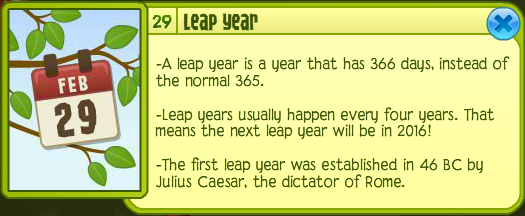Today's a special day – Leap Year Day. It only happens every
four years, so let's celebrate.
Imagine raking leaves on Christmas, or shoveling snow on a
Memorial Day. What about going for a swim on Thanksgiving?
Without Leap Year Day , which takes place every four years,
what could happen. "If we didn't have leap years, our calendar would be
totally scrambled," says Geoff Chester of the U.S. Naval Observatory in
Washington, D.C., the nation's official timekeepers.
Why Leap
Year Day?
Our calendar is normally 365 days long. It was created to
match the cycles of the seasons. But Roman Dictator Julius Caesar noticed a
problem: The Earth doesn’t circle the sun in exactly 365 days. It actually
takes 365 and one-quarter days. He figured out that the extra fraction of a day
would cause the calendar to grow apart from the seasons over time. Over 100
years, the seasons would shift about 24 days. Spring would start on April 13
instead of March 20.
Caesar used maths to figure out a way to stop the calendar
from shifting. He decided to add an extra day to the month of February every
four years. His idea helped keep the seasons and calendar matched up. Even so,
it still wasn’t perfect -- his calendar was adding too many days.
In 1582, Pope Gregory XIII worked on Caesar’s idea. His
calendar, called the Gregorian calendar, dictates that every year that is
evenly divided by 400 is a leap year. Turn-of-the-century years, or years
ending in “00,” would not be leap years unless they could be divided evenly by
400. These complicated equations help keep the calendar in balance with the
orbit of the Earth. Today, we still use the Gregorian calendar. In about 3,000
years, the calendar will be only one day out of step with the seasons. It’s
still not perfect, but mathematicians decided it was as close as we could get.
A
Complicated Birthday
So what happens when someone is born on Leap Day? Do these
Pisces celebrate their birthday each year, or do they instead have to wait four
years to age? Statistics show that on non-leap-years, about 80 percent still
celebrate their birthdays in February, rather than on March 1. Birth
certificates and most government agencies use February 29 for people who were
born on Leap Day, but some states use March 1 for official purposes.
How rare is a Leap Day birthday? The chance of someone being
born on a Leap Day is 1 out of 1,461, or less than 1%. Babies born on February
29 are sometimes known as leapers or leaplings. Happy birthday to them! Happy
birthday to them! How will you celebrate Leap Day?






